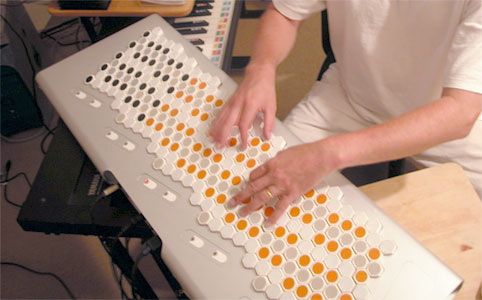
The Terpstra MIDI Keyboard is a generalized MIDI keyboard with 280 velocity-sensitive keys. It’s designed for playing microtonal music, offering 55 notes per octave.
According to the Cortex site, its design is well suited for any MIDI-based application that requires a rich control surface.
It looks to be a design prototype – there’s no marketing info available at the site. If you have any additional info, let me know!

it’s stunning. more natural feeling than a piano, by far.
meester bits
Have you used this? If so, what can you tell me about it?
The Terpstra is not exactly Mysterious, it is ground breaking and amazing, and simply not in production yet ( but should be)
I played one of these at the Queens College NY. Upon seeing it, I could immediately appreciate the manufacturing quality of this prototype – Well made thick aluminum case with a look and solidity that is reminiscent of Apple G5 and 8-core towers. There is apparently 1 one octave Terpstra and 2 working 5 octave Terpstra prototypes. The one I saw (pictured above) was really great with full velocity on every key. I am a keyboard player and the feel of the Terpstra was really exceptional and had very expressive touch that was lighter but much like a real piano, only faster. Each key has a removable magnetic key cap, so different colored or labeled key caps can be easily swapped around when you re-map the keys to a different scale. What amazes me was the amount of detailed thought that has gone into making this a real musicians performance tool. The key sensing for this also is a one of a kind because the electronics constantly monitor the position of every key (not not by triggering switches at the bottom of the key press and measuring the time differential) by magnetically sensing for the whole key throw. When a key is depressed, the entire change in position is monitored and translated to a very accurate and nuanced velocity by the time the key hits the bottom. Every key is easily re mappable and if mapped to a continuous controller, then slowly depressing any re-mapped key sends out continuous data like a fader in real time. It does all of this with no latency. I would LOVE to map some keys to sweep filters, and leave other keys as notes to trigger the sounds feeding through the filter. This WOULD be the funkiest microtonal thing ever!
I have read other posts around the net that dash the Terpstra off as yet another Janko etc, and although I can see how one could confuse it with a Janko, it is really much more. (BTW. you could map it as a Janko if you wished) The Terpstra blows the doors open with easy mappability and a key layout that, unlike the janko and other generalized keyboards, puts each key at a slightly different height – which when combined with the irregular shape of the front row of keys (see picture above) allows you to feel where your hands are on the keys without looking. This is similar to the way you can feel where you hands are by feeling the pattern of black and white keys on the piano. This means that for the first time you can play a matrix keyboard without having to constantly look at it to know where you are.
Every keyboard player with a serious view to the future of keyboard performance should have one of these. I do hope that someone puts this into production as the Terpstra’s touch response and overall musicality and feel make it a full head and shoulders above every other generalized keyboard I have tried. Kudos to Mr. Terpstra and his design team up in Canada as they have obviously spent a long time working out just what would be needed for this innovative and quality controller to allow it to kick the ass it does.
Hands Down: I will buy a Terpstra as soon as it goes into production.
The Terpstra didn’t get into production, but is available to purchase for a one-time limited edition of 20 pcs. See link below for infos, make sure to read the first post:
https://www.facebook.com/media/set/?set=oa.10150998052409482
the future
Jeez, this innovative Terpstra MIDI controller seems to beat them all! It not only offers us a uniform Kbd layout, but is also able to adapt to about any known Kbd layout!
Since I used to play the accordion, the nearest thing for me (or any standard piano player) would be the Janko layout.
I know, the Japanese Chromatone Janko Kbd offers just that, but is very expensive and its inbuilt Synths sound rather poor. Thus, I prefer to just buy the Terpstra MIDI controller to control a Synths of my choice with it. I also heard that Terpstra even offers a WYSIWYG Janko notation (similar to Klavarskribo). That would make relearning the Janko pattern a breeze!
Well, I’ll definitely keep an eye on this truly innovative Terpstra controller and a.s.a.p. acquire one.
It’s about time that computer technology improves our outdated Kbd layout and notation!!
http://www.indiegogo.com/projects/terpstra-keyboard-280-color-changing-continuous-controllers/x/608179
Hi folks, if you’re interested in getting a Terpstra, we have an indiegogo campaign live for the next 35 days; it may be the only chance we have to get this into production. Please spread to your networks!
http://www.indiegogo.com/projects/terpstra-keyboard-280-color-changing-continuous-controllers/x/608179